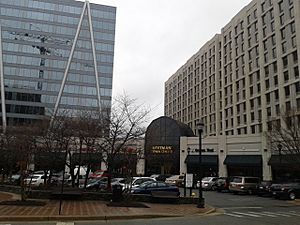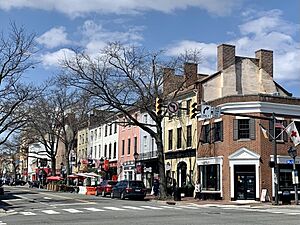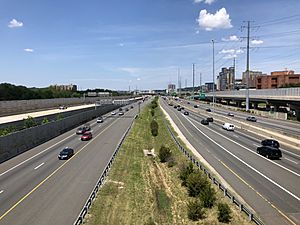Alexandria, Virginia facts for kids
Quick facts for kids
Alexandria
|
|||
|---|---|---|---|

The George Washington Masonic Memorial
|
|||
|
|||
| Country | United States | ||
| State | Virginia | ||
| County | None (Independent city) | ||
| Founded | 1749 | ||
| Incorporated (town) | 1779 | ||
| Incorporated (city) | 1852 | ||
| Incorporated (Independent city) | 1870 | ||
| Government | |||
| • Type | Council-manager | ||
| Area | |||
| • Total | 15.35 sq mi (39.75 km2) | ||
| • Land | 14.93 sq mi (38.68 km2) | ||
| • Water | 0.41 sq mi (1.07 km2) | ||
| Highest elevation | 287 ft (87 m) | ||
| Lowest elevation | 0 ft (0 m) | ||
| Population
(2020)
|
|||
| • Total | 159,467 |
||
| • Rank | 169th in United States 6th in Virginia |
||
| • Density | 10,680.97/sq mi (4,122.72/km2) | ||
| Demonym(s) | Alexandrian | ||
| Time zone | UTC−5 (EST) | ||
| • Summer (DST) | UTC−4 (EDT) | ||
| ZIP Codes |
20598, 22301-22315, 22320, 22331-22334, 22350
|
||
| Area codes | 703 and 571 | ||
| FIPS code | 51-01000 | ||
| GNIS feature ID | 1492456 | ||
| Primary Airports | Ronald Reagan Washington National Airport Dulles International Airport |
||
| Commuter rail | Virginia Railway Express | ||
Alexandria is an independent city in the northern region of the Commonwealth of Virginia, United States. It lies on the western bank of the Potomac River approximately 7 miles (11 km) south of downtown Washington, D.C. Alexandria is the third-largest principal city of the Washington metropolitan area, which is part of the larger Washington–Baltimore combined statistical area. As of 2022, the city's population of 159,467 made it the sixth-most populous city in Virginia and the 173rd-most populous city in the nation.
Like the rest of Northern Virginia and Central Maryland, present-day Alexandria has been influenced by its proximity to the U.S. capital. It is largely populated by professionals working in the federal civil service, in the U.S. military, or for one of the many private companies which contract to provide services to the U.S. federal government. The city's largest employers include the U.S. Department of Defense and the Institute for Defense Analyses. Alexandria is the highest-income independent city in Virginia.
The historic center of Alexandria is known as Old Town Alexandria, or simply "Old Town". With its concentration of boutiques, restaurants, antique shops and theaters, it is a major draw for city residents and visitors. Like Old Town, many Alexandria neighborhoods are compact and walkable. A large portion of adjacent Fairfax County, mostly south but also west of the city, has Alexandria mailing addresses. However, this area is under the jurisdiction of Fairfax County's government and separate from the independent city. The city is therefore sometimes referred to as the "City of Alexandria" to avoid confusion.
Contents
History
Colonial era
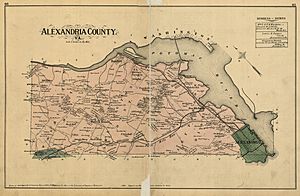
The first European settlement was established in 1695 in what was then the English Colony of Virginia. Virginia's comprehensive Tobacco Inspection Law of 1730 mandated that all tobacco grown in the colony must be brought to locally designated public warehouses for inspection before sale: one of the sites designated for a warehouse on the upper Potomac River was at the mouth of Hunting Creek. However, the ground being unsuitable at that location, the warehouse was established a half mile up-river, where the water ran deep near the shore.
Following the 1745 settlement of the colony's 10-year-long dispute with Lord Fairfax over the western boundary of the Northern Neck Proprietary—the Privy Council in London finding in favor of Lord Fairfax's expanded claim—some of the gentry class of Fairfax County banded together to form the Ohio Company of Virginia. Their intent was to establish trade into the interior of America and for this they required an entrepot close to the head of navigation on the Potomac. The Hunting Creek tobacco warehouse offered the best location for a trading port which could accommodate sailing ships. However, many of the local tobacco planters wanted a new town to be sited up Hunting Creek, away from nonproductive fields along the river.
Around 1746, Captain Philip Alexander II (1704–1753) moved to what is south of present Duke Street in Alexandria. His estate, which consisted of 500 acres (2.0 km2), was bounded by Hunting Creek, Hooff's Run, the Potomac River, and approximately the line which would become Cameron Street. At the opening of Virginia's 1748–49 legislative session, there was a petition submitted in the House of Burgesses on November 1, 1748, that the "inhabitants of Fairfax (Co.) praying that a town may be established at Hunting Creek Warehouse on Potowmack River," as Hugh West was the owner of the warehouse. The petition was introduced by Lawrence Washington (1718–1752), the representative for Fairfax County and, more importantly, the son-in-law of William Fairfax and a founding member of the Ohio Company. To support the company's push for a town on the river, Lawrence's younger brother George Washington, an aspiring surveyor, made a sketch of the shoreline touting the advantages of the tobacco warehouse site.
Since the river site was amidst his estate, Philip opposed the idea and strongly favored a site at the head of Hunting Creek (also known as Great Hunting Creek). It has been said that in order to avoid a predicament the petitioners offered to name the new town Alexandria, in honor of Philip's family. As a result, Philip and his cousin Captain John Alexander (1711–1763) gave land to assist in the development of Alexandria, and are thus listed as the founders. This John was the son of Robert Alexander II (1688–1735). On May 2, 1749, the House of Burgesses approved the river location and ordered "Mr. Washington do go up with a Message to the Council and acquaint them that this House have agreed to the Amendments titled An Act for erecting a Town at Hunting Creek Warehouse, in the County of Fairfax." A "Public Vendue" (auction) was advertised for July, and the county surveyor laid out street lanes and town lots. The auction was conducted on July 13–14, 1749.
Almost immediately upon establishment, the town founders called the new town "Belhaven", believed to be in honor of a Scottish patriot, John Hamilton, 2nd Lord Belhaven and Stenton, the Northern Neck tobacco trade being then dominated by Scots. The name Belhaven was used in official lotteries to raise money for a Church and Market House, but it was never approved by the legislature and fell out of favor in the mid-1750s. The town of Alexandria did not become incorporated until 1779.
In 1755, General Edward Braddock organized his fatal expedition against Fort Duquesne at Carlyle House in Alexandria. In April 1755, the governors of Virginia, and the provinces of Maryland, Pennsylvania, Massachusetts, and New York met to determine upon concerted action against the French in America.
In March 1785, commissioners from Virginia and Maryland met in Alexandria to discuss the commercial relations of the two states, finishing their business at Mount Vernon. The Mount Vernon Conference concluded on March 28 with an agreement for freedom of trade and freedom of navigation of the Potomac River. The Maryland legislature, in ratifying this agreement on November 22, proposed a conference among representatives from all the states to consider the adoption of definite commercial regulations. This led to the calling of the Annapolis Convention of 1786, which in turn led to the calling of the Federal Convention of 1787.
In 1791, Alexandria was included in the area chosen by George Washington to become the District of Columbia.
Early 19th century
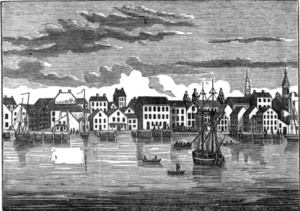
In 1814, during the War of 1812, a British fleet launched a successful Raid on Alexandria, which surrendered without a fight. As agreed in the terms of surrender the British looted stores and warehouses of mainly flour, tobacco, cotton, wine, and sugar. In 1823 William Holland Wilmer, Francis Scott Key, and others founded the Virginia Theological Seminary. From 1828 to 1836, Alexandria was home to the Franklin & Armfield Slave Market, one of the largest slave trading companies in the country. By the 1830s, they were sending more than 1,000 slaves annually from Alexandria to their Natchez, Mississippi, and New Orleans markets to help meet the demand for slaves in Mississippi and surrounding states. Later owned by Price, Birch & Co., the slave pen became a jail under Union occupation.
A portion of the City of Alexandria—most of the area now known as "Old Town" as well as the areas of the city northeast of what is now King Street—and all of today's Arlington County share the distinction of having been originally in Virginia, ceded to the U.S. Government to form the District of Columbia, and later retroceded to Virginia by the federal government in 1846, when the District was reduced in size to exclude the portion south of the Potomac River. Over time, a movement grew to separate Alexandria from the District of Columbia (the District of Columbia retrocession). As competition grew with the port of Georgetown and the Chesapeake and Ohio Canal fostered development on the north side of the Potomac River, the city's economy stagnated, together with the loss of representation and rights to vote and failed expectations for economic benefit from the new district. Alexandria was also an important port and market in the slave trade, and there were increasing talk of abolition of slavery in the national capital. Alexandria's economy would suffer greatly if slavery were outlawed. After a referendum, voters petitioned Congress and Virginia to return the area to Virginia. Congress retroceded the area to Virginia on July 9, 1846. The City of Alexandria was re-chartered in 1852 and became independent of Alexandria County in 1870. The remaining portion of Alexandria County changed its name to Arlington County in 1920.
Late 19th century
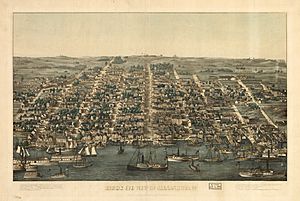
The first fatalities of the North and South in the American Civil War occurred in Alexandria. Within a month of the Battle of Fort Sumter, where two died, Union troops occupied Alexandria, landing troops at the base of King Street on the Potomac River on May 24, 1861. A few blocks up King Street from their landing site, the commander of the New York Fire Zouaves, Colonel Elmer E. Ellsworth, sortied with a small detachment to retrieve a large Confederate flag displayed on the roof of the Marshall House Inn that had been visible from the White House. While descending from the roof, Ellsworth was shot dead by Captain James W. Jackson, the hotel's proprietor. One of the Ellsworth's soldier immediately killed Jackson. Ellsworth was publicized as a Union martyr, and the incident generated great excitement in the North, with many children being named for him. Jackson's death defending his home caused a similar, though less lasting sensation, in the South.
Alexandria remained under military occupation until the end of the war. Fort Ward, one of a ring of forts built by the Union army for the defense of Washington, D.C., is located inside the boundaries of present-day Alexandria. After the creation by Washington of the state of West Virginia in 1863 and until the close of the war, Alexandria was the seat of the so-called Restored Government of Virginia, also known as the "Alexandria Government". During the Union occupation, a recurring contention between the Alexandria citizenry and the military occupiers was the Union army's periodic insistence that church services include prayers for the President of the United States. Failure to do so resulted in incidents including the arrest of ministers in their church.
Escaped African American slaves poured into Alexandria. Safely behind Union lines, the cities of Alexandria and Washington offered comparative freedom and employment. Alexandria became a major supply depot and transport and hospital center for the Union army. Until the Emancipation Proclamation, escaped slaves legally remained the property of their owners. Therefore, they were labeled contrabands to avoid returning them to their masters. Contrabands worked the Union army in various support roles. By the fall of 1863, the population of Alexandria had exploded to 18,000—an increase of 10,000 people in 16 months.
As of ratification of the Fifteenth Amendment, Alexandria County's black population was more than 8,700, or about half the total number of residents in the county. This newly enfranchised constituency provided the support necessary to elect the first black Alexandrians to the City Council and the Virginia Legislature.
20th century
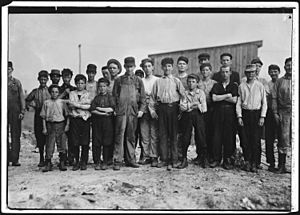
At the turn of the 20th century the most common production in the city was glass, fertilizer, beer and leather. The glass often went into beer bottles. Much of the Virginia Glass Company effort went to supply the demands of the Robert Portner Brewing Company, until the fire destroyed the St. Asaph Street plant on February 18, 1905. The Old Dominion Glass Company also had a glass works fall to fire, then built a new one. The Belle Pre Bottle Company held a monopoly on a milk bottle that they patented, yet that organization only lasted 10 years. Most businesses were smaller where the business occupied the first floor of a building and the owner and family lived above. Prohibition closed the Portner Brewing in 1916.
President Woodrow Wilson visited the Virginia Shipbuilding Corporation on May 30, 1918 to drive the first rivet into the keel of the USS Gunston Hall. In 1930, Alexandria annexed the town of Potomac. That town, adjacent to Potomac Yard, had been laid out beginning in the late 19th century and incorporated in 1908. In 1938 the Mt. Vernon Drive-In cinema opened. In 1939 the segregated public library experienced a sit-in organized by Samuel Wilbert Tucker. In 1940 both the Robert Robinson Library, which is now the Alexandria Black History Museum, and the Vernon Theatre opened Jim Morrison of The Doors, as well as Cass Elliot and John Phillips of The Mamas & The Papas attended the George Washington High School in the 1950s.
In 1955 the Fords moved to Alexandria from Georgetown. In March 1959 Lieutenant Colonel William Henry Whalen, the "highest-ranking American ever recruited as a mole by the Russian Intelligence Service," provided Colonel Sergei A. Edemski three classified Army manuals in exchange for $3,500 at a shopping center parking lot within the city. Agents of the Federal Bureau of Investigation later arrested Whalen on July 12, 1966 at his home in the city. In 1961 the Woodrow Wilson Bridge opened.
In 1965 the city integrated schools. In 1971 the city consolidated all high school students into T. C. Williams High School. The same year that head coach Herman Boone joined the school and lead the football team to at 13-0 season, state championship, and national championship runner-up; the basis for the 2000 film Remember the Titans were Boone was portrayed by Denzel Washington. In 1972 Clifford T. Cline purchased the 1890 Victorian house at 219 King Street and converted it into the Creole serving Two-Nineteen Restaurant. In 1973 Nora Lamborne and Beverly Beidler became the first women elected to the city council. In 1974 the Torpedo Factory Art Center opened. In 1983 the King Street–Old Town Station and Eisenhower Avenue Station both opened. In 1984 the Islamic Saudi Academy opened. and Parker-Gray historic district In 1991 Patricia Ticer became the first women elected mayor.
Geography
According to the United States Census Bureau, the city has a total area of 15.5 square miles (40.1 km2), of which 15.0 square miles (38.9 km2) is land and 0.42 square miles (1.1 km2), or 2.85%, is water. Alexandria is bounded on the east by the Potomac River, on the north and northwest by Arlington County, and on the south by Fairfax County. The western portions of the city were annexed from those two entities beginning in the 1930s.
The addressing system in Alexandria is not uniform and reflects the consolidation of several originally separate communities into a single city. In Old Town Alexandria, building numbers are assigned north and south from King Street and west (only) from the Potomac River. In the areas formerly in the town of Potomac, such as Del Ray and St. Elmo, building numbers are assigned east and west from Commonwealth Avenue and north (only) from King Street. In the western parts of the city, building numbers are assigned north and south from Duke Street.
The ZIP code prefix 223 uniquely identifies the Alexandria postal area. However, the Alexandria postal area extends into Fairfax County and includes addresses outside of the city. Delivery areas have ZIP codes 22301, 22302, 22203, 22304, 22305, 22306, 22307, 22308, 22309, 22310, 22311, 22312, 22314, and 22315, with other ZIP codes in use for post office boxes and large mailers (22313, 22331, 22332, 22333).
There is one national protected area in Alexandria:
Adjacent jurisdictions
- Arlington County, Virginia – north
- Fairfax County, Virginia – west and south
- District of Columbia – northeast
- Prince George's County, Maryland – east
Demographics
| Historical population | |||
|---|---|---|---|
| Census | Pop. | %± | |
| 1790 | 2,748 | — | |
| 1800 | 4,971 | 80.9% | |
| 1810 | 7,227 | 45.4% | |
| 1820 | 8,218 | 13.7% | |
| 1830 | 8,241 | 0.3% | |
| 1840 | 8,459 | 2.6% | |
| 1850 | 8,734 | 3.3% | |
| 1860 | 12,652 | 44.9% | |
| 1870 | 13,570 | 7.3% | |
| 1880 | 13,659 | 0.7% | |
| 1890 | 14,339 | 5.0% | |
| 1900 | 14,528 | 1.3% | |
| 1910 | 15,329 | 5.5% | |
| 1920 | 18,060 | 17.8% | |
| 1930 | 24,149 | 33.7% | |
| 1940 | 33,523 | 38.8% | |
| 1950 | 61,787 | 84.3% | |
| 1960 | 91,023 | 47.3% | |
| 1970 | 110,927 | 21.9% | |
| 1980 | 103,217 | −7.0% | |
| 1990 | 111,183 | 7.7% | |
| 2000 | 128,283 | 15.4% | |
| 2010 | 139,966 | 9.1% | |
| 2020 | 159,467 | 13.9% | |
| U.S. Decennial Census 1790–1960 1900–1990 1990–2000 2010-2020 2010 2020 |
|||
2020 Census
| Race / Ethnicity | Pop 2010 | Pop 2020 | % 2010 | % 2020 |
|---|---|---|---|---|
| White alone (NH) | 74,878 | 78,519 | 53.50% | 49.24% |
| Black or African American alone (NH) | 29,778 | 31,314 | 21.28% | 19.64% |
| Native American or Alaska Native alone (NH) | 327 | 217 | 0.23% | 0.14% |
| Asian alone (NH) | 8,351 | 11,205 | 5.97% | 7.03% |
| Pacific Islander alone (NH) | 109 | 77 | 0.08% | 0.05% |
| Some Other Race alone (NH) | 485 | 1,026 | 0.35% | 0.64% |
| Mixed Race/Multi-Racial (NH) | 3,514 | 7,737 | 2.51% | 4.85% |
| Hispanic or Latino (any race) | 22,524 | 29,372 | 16.09% | 18.42% |
| Total | 139,966 | 159,467 | 100.00% | 100.00% |
Note: the US Census treats Hispanic/Latino as an ethnic category. This table excludes Latinos from the racial categories and assigns them to a separate category. Hispanics/Latinos can be of any race.
2010 Census
At the 2010 census, there were 139,966 people, 68,082 households and 30,978 families residing in the city. The population density was 8,452.0 per square mile (3,262.9/km2). There were 68,082 housing units at an average density of 4,233.2 per square mile (1,634.2/km2). The racial/ethnic mix of the population was :
- 60.9% White
- 21.8% African American
- 6.0% Asian (1.3% Indian, 1.0% Filipino, 0.9% Chinese, 0.8% Korean, 0.5% Thai, 0.3% Vietnamese, 0.2% Japanese, 1.0% Other)
- 0.4% Native American
- 0.1% Pacific Islander
- 3.7% from two or more races
- 16.1% of the population were Hispanics or Latinos of any national origin (4.6% Salvadoran, 1.7% Mexican, 1.6% Honduran, 1.1% Guatemalan, 1.1% Puerto Rican, 0.9% Bolivian, 0.8% Peruvian, 0.4% Colombian)
In 2000, there were 61,889 households, of which 18.6% had children under the age of 18 living with them, 32.2% were married couples living together, 9.2% had a female householder with no husband present, and 55.2% were non-families. 43.4% of all households were made up of individuals, and 6.8% had someone living alone who was 65 years of age or older. The average household size was 2.04 and the average family size was 2.87.
The age distribution was 16.8% under the age of 18, 9.2% from 18 to 24, 43.5% from 25 to 44, 21.5% from 45 to 64, and 9.0% who were 65 years of age or older. The median age was 34 years. For every 100 females, there were 93.5 males. For every 100 females age 18 and over, there were 91.7 males.
According to 2019 Census Bureau data, the median household income was $103,284 and median family income was $130,395. Additionally, 8.6% of the population of the population were below the poverty line. 14.2% of those under the age of 18 and 3.1% of those 65 and older were living below the poverty line.
65.9% of Alexandria residents have attained a bachelor's degree or higher, compared with a 39.6% statewide.
Economy
Companies headquartered in Alexandria include Crooked Beat Records, Five Guys, the Institute for Defense Analyses (IDA), The Motley Fool, Oblon law firm, Pentagon Federal Credit Union (PenFed), Port City Brewing Company, Purple Strategies, ThinkFun, and VSE. Several federal agencies are based in Alexandria, including the National Credit Union Administration, United States Patent and Trademark Office, National Science Foundation, Office of the Inspector General, U.S. Department of Defense, and the Food and Nutrition Service. The Department of Defense Education Activity (DoDEA), the federal school system for military dependents, is headquartered in Alexandria.
Alexandria is home to many charities and non-profit organizations including the national headquarters of Catholic Charities, Citizens for the Republic, Global Impact, Good360, International Centre for Missing & Exploited Children, Islamic Relief USA, United Way, and Volunteers of America. Trade associations located in the city include the American Counseling Association, the Human Resource Certification Institute, the Society for Human Resource Management, the National Society of Professional Engineers, the National Beer Wholesalers Association, the American Society of Clinical Oncology, National Industries for the Blind, American Physical Therapy Association, the National Association of Convenience Stores, and the American International Automobile Dealers Association. Alexandria also has a Chamber of Commerce and other business associations including the West End Business Association, the Del Ray Business Association and the Old Town Business Association.
Major employment sectors in Alexandria include management consulting, business and finance, office and administrative support, computer and mathematical, sales, and legal. Jobs in Alexandria are highly concentrated around the city's Metrorail stations, primarily in Old Town North and the Braddock Road area, Old Town, and Carlyle near the Eisenhower Avenue station, as well as along the I-395 corridor on the west side of the city.
13% of people that work in Alexandria live in the city, while 87% commute in, with 37% of those commuters being from Fairfax County. An additional 61,000 people commute out of Alexandria to work. 35% commute to Washington, D.C., and 29% commute to Fairfax County. As of March 2024, 2.0% of Alexandria residents are unemployed.
| # | Employer | # of employees |
|---|---|---|
| 1 | United States Department of Defense - Mark Center | 8,000 |
| 2 | United States Department of Commerce (includes Patent and Trademark Office) | 5,500 |
| 3 | City of Alexandria | 2,700 |
| 4 | Alexandria City Public Schools | 2,500 |
| 5 | Washington Metropolitan Area Transit Authority | 1,200 |
| 6 | United States Department of Agriculture | 800 |
| 7 | United States General Services Administration | 600 |
| # | Employer | # of employees |
|---|---|---|
| 1 | Inova Health System | 1,700 |
| 2 | Institute for Defense Analyses | 750 |
| 3 | Systems Planning & Analysis Inc | 700 |
| 4 | Goodwin House | 700 |
| 5 | Kearney & Company | 600 |
| 6 | CRS Facility Service | 400 |
| 7 | United Parcel Service (UPS) | 350 |
Culture

Events
A popular Christmas time attraction in Alexandria is the Scottish Christmas Walk, which was established in 1969. The event, which involves a parade through the center of Old Town Alexandria, celebrates the city's Scottish heritage, and is the centerpiece of a yearly holiday festival. It serves as a fundraiser for social services in Alexandria. Other parades in Old Town celebrate Saint Patrick's Day and the birthday of George Washington. Other annual events include the Red Cross Waterfront Festival in June, the city's birthday celebration with fireworks show in July, various ethnic heritage days at Tavern Square, and "First Night Alexandria" on New Year's Eve.
These parades and other official events are typically led by Alexandria's town crier, who, often dressed in elaborately, by a tradition dating to the 18th century, in a red coat, breeches, black boots and a tricorne hat, welcomes participants.
Sites of Interest
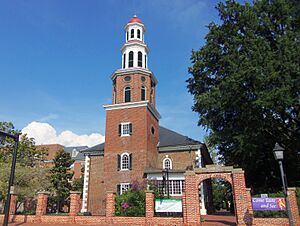
Landmarks within the city include the George Washington Masonic National Memorial (also known as the Masonic Temple) and Observation Deck, Christ Church, Gadsby's Tavern, Stabler-Leadbeater Apothecary Shop, John Carlyle House, Lee-Fendall House, Robert E. Lee's boyhood home, and the Alexandria City Hall with the adjacent Market Square. Other sites of historical interest in the city include Fort Ward Park and Museum, Phoenix Mill, and the Alexandria Canal lock re-creation at Canal Office Center. The Alexandria Black History Museum, Alexandria Archaeology Museum, and the Lyceum display various aspects of the city's history.
The Torpedo Factory Art Center, located on the Old Town waterfront, is a former torpedo factory that now serves as an art center filled with independent art studios and exhibits. The Athenaeum is another center for the arts. Also located in Old Town is Little Theatre of Alexandria, a community theatre at 600 Wolfe Street. South of Old Town on the Potomac River is the Jones Point Light and the nearby south cornerstone of the original District of Columbia. Immediately west of Old Town is the United States Patent and Trademark Office which includes the National Inventors Hall of Fame Museum. The Birchmere is a concert hall that features musical acts as well as ethnic and comedic performers. Site of interests with Alexandria addresses but located outside of the city include River Farm, Collingwood Library & Museum, Green Spring Gardens Park, Huntley Meadows Park, Historic Huntley, Pope-Leighey House (designed by Frank Lloyd Wright), Woodlawn Plantation, and George Washington's Grist Mill and Mount Vernon Estate.
In 1830, John Hollensbury's home in Alexandria was one of two homes directly bordering an alleyway that received a large amount of horse-drawn wagon traffic and loiterers. In order to prevent people from using the alleyway, Hollensbury constructed a 7 feet (2.1 m) wide, 25 feet (7.6 m) deep, 325-square-foot (30.2 m2), two-story home using the existing brick walls of the adjacent homes for the sides of the new home. The brick walls of the Hollensbury Spite House living room have gouges from wagon-wheel hubs; the house is still standing, and is occupied.
The Oswald Durant Center in the Upper King Street neighborhood of the Old Town is named after Dr. Oswald Durant, one of the first African American doctors in Alexandria.
Media
Alexandria has two local weekly newspapers: the Alexandria Gazette Packet and the Alexandria Times. The Alexandria Gazette was once published in the city from 1834 to 1974.
Sports
The city is home to the Alexandria Aces of the Cal Ripken Sr. Collegiate Baseball League. The team's home field is Frank Mann Field. Alexandria had previously been home of one professional sports team, the Alexandria Dukes, a minor league baseball team which moved to Woodbridge in 1984 to become The Prince William Pirates (now known as the Fredericksburg Nationals).
Parks and recreation
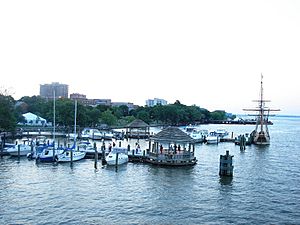
Alexandria has over 900 acres (3.6 km2) of protected open space with 566 acres of city-owned park land and 10 recreation centers, of which Chinquapin is one of the largest. Chinquapin offers facilities for swimming, tennis, racquetball, and other sports. The city also organizes several sports leagues throughout the year including volleyball, softball and basketball.
The city is home to Cameron Run Regional Park, operated by NOVA Parks, which includes a water park, a miniature golf course, and batting cages. NOVA Parks also operates the Winkler Botanical Preserve in the city's West End. A portion of the Mount Vernon Trail, a popular bike and jogging path, runs through Old Town near the Potomac River on its way from the Mount Vernon Estate to Roosevelt Island in Washington, D.C. There is also a largely unbroken line of parks stretching along the Alexandria waterfront.
Education
Colleges and universities
Virginia Tech's Washington-Alexandria Architecture Center, also known as WAAC, is located on Prince Street in Old Town, offering graduate programs in Urban Affairs and Planning, Public and International Affairs, Architecture, and Landscape Architecture. In 2018, Virginia Tech announced the construction of an "Innovation Campus" in Potomac Yard with graduate programs in computer science and computer engineering. Virginia Commonwealth University operates a Northern Virginia branch of its School of Social Work and The George Washington University also has a campus near the King Street–Old Town station. This campus mainly offers professional and vocational programs, such as an executive MBA program, urban planning and security studies. The city also has a campus of the Northern Virginia Community College. The largest seminary in the Episcopal Church, Virginia Theological Seminary, is located on Seminary Road.
Primary and secondary schools
The city is served by the Alexandria City Public Schools system. Alexandria's public school system consists of twelve elementary schools for grades Kindergarten through 5th grade, with three of them also offering Pre-K. Two schools, Patrick Henry and Jefferson-Houston, are Pre-K through 8th grade schools while the middle schools, George Washington and Francis C. Hammond, serve 6th through 8th graders. Minnie Howard Ninth Grade Center serves 9th graders while the Alexandria City High School serves 10th through 12th for the entire city.
The demographics of the public school system contrast with those of the city. In 2008, only 14% of the students at Francis C. Hammond Middle School were non-Hispanic whites, compared to about 60% when looking at the city as a whole. 27% were of Hispanic descent, and 48% were black. About 9% of the school was of Asian descent. In 2004, 62% of school-going children received free lunches; by 2008, that number had decreased to 56%. At George Washington Middle School, 41% of students are non-Hispanic whites, 34% were Hispanic, 21% was black, and 2% of the students were Asian; 52% of students received free lunch. Alexandria City High School follows this trend as well; 23% of the students were classified as non-Hispanic whites, 25% as Hispanic, 44% as black, and 7% of the school was Asian; 47% of all students received free lunch.
Alexandria is home to private schools such as St. Stephen's and St. Agnes School, Bishop Ireton High School, and Episcopal High School. Also in the city are Alexandria Country Day School, Commonwealth Academy, the Basilica School of Saint Mary, St. Rita's Catholic School, Blessed Sacrament School, and Global Health College.
Infrastructure
Healthcare
Alexandria is served by Inova Alexandria Hospital. The city's health department operates a health clinic at Mark Center in the city's West End and a teen wellness center at Alexandria City High School.
Transportation
Concurrent highways I-95 and I-495 (the Capital Beltway), including the Woodrow Wilson Bridge over the Potomac River, roughly parallels the city's southern boundary with Fairfax County before very briefly passing through D.C. and entering Maryland. Interstate 395 crosses north and south through the western part of the city. Alexandria is bisected east and west by State Route 7 (VA 7/King Street). The most western section of King Street in the city was once the terminus of the Leesburg Turnpike. VA 7 terminates at State Route 400 (VA 400/Washington Street), which connects the northern and southern segments of George Washington Memorial Parkway (G.W. Parkway). State Route 236 (VA 236/Duke Street) runs east–west along the southern side of the city, also terminating at VA 400 in Old Town. Other primary state highways serving Alexandria include the short limited-access State Route 241 (Telegraph Road), as well as multiple thoroughfares serving the western side of the city, which are State Route 401 (Van Dorn Street), State Route 402 (Quaker Lane), and State Route 420 (Seminary Road in the west, Janneys Lane in the east). U.S. Route 1 (Richmond Highway) passes north–south through the city, parallel and west of Washington Street and the G.W. Parkway. Through Old Town, the highway follows Patrick and Henry Streets.
The Alexandria city government operates its own mass transit system, the DASH bus, connecting points of interest with local transit hubs. Since 2021, DASH is fare-free. DASH also offers a "trolley" diesel bus service on King Street from the King Street–Old Town Metro station to the Waterfront. Metrobus also serves Alexandria along with Metrorail's Blue and Yellow Lines with stops at Potomac Yard, Braddock Road, King Street-Old Town, Eisenhower Avenue, and Van Dorn Street. Hornblower Cruises operates the Potomac Water Taxi to and from Georgetown and The Wharf development in D.C. and the National Harbor development in Prince George's County.
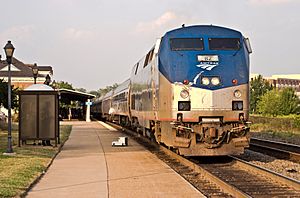
Alexandria Union Station, the city's historic train station, has Amtrak intercity services and the Virginia Railway Express (VRE) regional rail service. The station is directly adjacent to the King Street–Old Town Metro station. The traditional boundary between Old Town and the latterly annexed sections of the city follows the railway acquired by Virginia in 2021 and formerly owned by CSX Transportation. In addition, Norfolk Southern Railway operates a freight rail line and a transload terminal in the city.
Capital Bikeshare, a bicycle-sharing public transportation system, launched in Alexandria in 2012. The system has 62 rental locations throughout the city. The East Coast Greenway and Mount Vernon Trail cycle routes pass through Alexandria.
Notable people
-
Diedrich Bader, actor
 George Washington was a Town Trustee, philanthropist, and resident.
George Washington was a Town Trustee, philanthropist, and resident. - Hannibal Brumskine III, internet entrepreneur
- Stewart Copeland, drummer for The Police
- Leon Day, Hall of Fame baseball pitcher who played in the Negro leagues
- Elena Delle Donne, forward-guard, Washington Mystics, WNBA champion, two-time league MVP
- Stefon Diggs, wide receiver for the Houston Texans
- Donna Dixon, former actress, model
- William O. Douglas, American jurist who served as an Associate Justice of the Supreme Court of the US 1939–75, and environmentalist resided in Old Town for four decades
- Chad Dukes, Alexandria, Virginia radio personality, pioneer in podcasting
- Marion Moncure Duncan, 25th President General of the Daughters of the American Revolution
- Cass Elliot and John Phillips of The Mamas & The Papas
- Charles Esten, actor, singer
- Margaret Fetterolf, previously unidentified murder victim discovered in Woodlawn, Baltimore County, Maryland in 1976, identified in 2021
- Gerald R. Ford, former President of the United States, lived at 1521 Mount Eagle Place in Parkfairfax, and later at 514 Crown View Drive, where he lived during his term as vice president and for the first ten days of his presidency
- Rick Franklin, a Piedmont blues guitarist, singer and songwriter, was born in Alexandria
- Dave Grohl, founder and frontman of Foo Fighters, drummer for Nirvana
- Moses Hepburn, first African American town councilor of West Chester, Pennsylvania
- Sarah Gibson Jones, African American educator, journalist, poet, lecturer, and clubwoman
- Archie Kao, actor, who grew up in Alexandria and graduated from George Mason University in nearby Fairfax, Virginia.
- Thomas Kail, theater director
- Angus King, U.S. Senator for the state of Maine
- Gregory Lawler, mathematician who won the 2019 Wolf Prize in mathematics
- Henry Lee III, often known by his nickname "Light-Horse Harry", Revolutionary War lieutenant colonel, Virginia Governor, father of Robert E. Lee moved to Alexandria in 1810
- Robert E. Lee, Civil War general, grew up on Oronoco Street
- George Washington, owned a house in Alexandria where he would stay while conducting business. He was also active in the local government and masonic lodge.
- Thad Levine, general manager of Minnesota Twins, was born in Alexandria
- Emma Louise Lowe, American musician, educator, former First Lady of American Samoa and former First Lady of Guam
- Noah Lyles, Olympian
- Scott McKenzie, musician
- Jim Morrison of The Doors lived at 310 Woodland Terrace 1959–61
- David Lynch, filmmaker
- Dean Muhtadi, former American football player and former WWE wrestler
- Dermot Mulroney, American Actor, known for his role in My Best Friend's Wedding, among others
- Mick Mulvaney, Director of the Office of Management and Budget and former U.S. Congressman representing South Carolina, born in Alexandria
- Richard M. Nixon, former President of the United States, lived at 3426 Gunston Rd in Parkfairfax
- Sandie Pendleton, Lieutenant Colonel in the C.S Army, Adjutant to Stonewall Jackson and other Confederate Generals.
- Eddie Royal, Chicago Bears wide receiver
- Willard Scott, national television personality, grew up in Rosemont
- Garren Stitt, actor known for his roles in General Hospital and Andi Mack
- Nicholas Trist, Diplomat who negotiated the Treaty of Guadeloupe Hidalgo
- Kali Uchis, singer
- Wernher von Braun, NASA rocket scientist, residence on Vicar Lane, buried in Ivy Hill Cemetery
- Ella Wall Van Leer, American artist, architect and women's rights activist
- Richard Hooker Wilmer, former Episcopal bishop, second Bishop of Alabama
- Megan Young, Miss World Philippines 2013 and Miss World 2013
Sister cities
Alexandria has four sister cities:
 Gyumri, Shirak Province, Armenia
Gyumri, Shirak Province, Armenia Helsingborg, Skåne County, Sweden
Helsingborg, Skåne County, Sweden Dundee, Scotland
Dundee, Scotland Caen, Calvados, France
Caen, Calvados, France
Alexandria was twinned with Gyumri as a means of showing goodwill in the wake of the 1988 Armenian earthquake.
See also
 In Spanish: Alexandria (Virginia) para niños
In Spanish: Alexandria (Virginia) para niños







